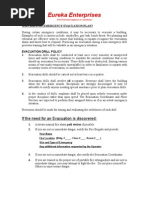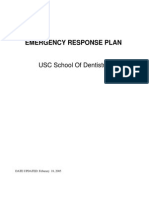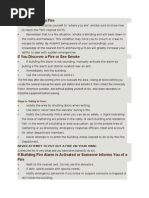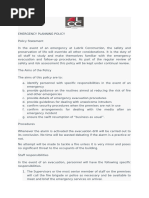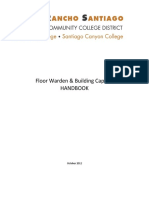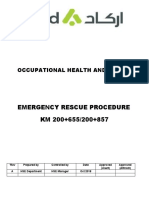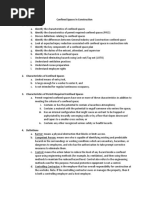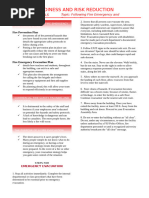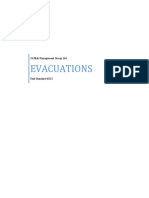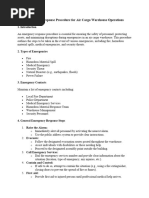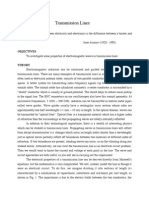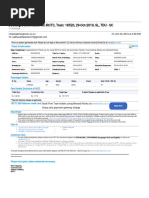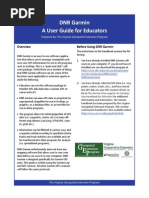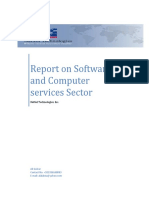Section VII: Evacuation Procedures For Building Occupants: Notes and Precautions
Section VII: Evacuation Procedures For Building Occupants: Notes and Precautions
Uploaded by
Odellien SajaCopyright:
Available Formats
Section VII: Evacuation Procedures For Building Occupants: Notes and Precautions
Section VII: Evacuation Procedures For Building Occupants: Notes and Precautions
Uploaded by
Odellien SajaOriginal Description:
Original Title
Copyright
Available Formats
Share this document
Did you find this document useful?
Is this content inappropriate?
Copyright:
Available Formats
Section VII: Evacuation Procedures For Building Occupants: Notes and Precautions
Section VII: Evacuation Procedures For Building Occupants: Notes and Precautions
Uploaded by
Odellien SajaCopyright:
Available Formats
Section VII: Evacuation Procedures for Building Occupants
1. When the fire alarm sounds, occupants should ensure that nearby personnel are aware of the emergency, quickly shutdown operating equipment (e.g., compressed gas cylinders), close doors (DO NOT LOCK) and exit the building using the established evacuation routes. 2. Occupants shall assist visitors, students and others who are not familiar with the plan to safely evacuate. 3. If you have been identified as having responsibility for Critical Operations Shutdown, refer to Section IX. 4. All occupants should proceed to their Designated Meeting Site and await further instructions from their Safety Monitor. 5. All personnel should know where primary and alternate exits are located, and be familiar with the various evacuation routes available. Floor plans with escape routes, alternate escape routes, exit locations and Designated Meeting Sites are located in Appendix II and are posted in the building. 6. Building occupants must NOT use elevators as an escape route in the event of a fire. Notes and Precautions: Portable fire extinguishers can be used for small fires. However, an immediate readiness to evacuate is essential. Never enter a room that is smoke filled. Before opening doors check to ensure it is not hot to the touch. If hot do not open. If warm open slowly to check room / hallway conditions.
Section VIII: Disabled Occupants
Employees requiring assistance upon exiting are listed in Appendix I however there may be disabled visitors in the building that also require assistance. The Safety Monitor must identify individuals needing assistance, attempt to locate individuals to assist in the evacuation or in relocating to the Area of Refuge, and notify the emergency response personnel of the person's location. Transporting of disabled individuals up or down stairwells should be avoided until emergency response personnel have arrived. Unless imminent life-threatening conditions exist in the immediate area occupied by a non-ambulatory or disabled person, relocation of the individual should be limited to a safe area on the same floor, in close proximity to an evacuation stairwell. Within the room there should be provided a flashlight, towel for hanging out window or bright colored marker to mark windows that cannot be opened.
Section IX: Critical Operations Shutdown
Critical Operation Shutdown: Critical operations, including equipment that must be shut off and persons designated to complete these actions are identified in Appendix I. Procedures for rapid shutdown should be predetermined for life safety and loss control purposes, as well as ensuring complete evacuations in a timely manner. Individuals should never jeopardize their own health and safety to complete the Critical Operations Shutdown.
You might also like
- SOP For Duties of Security GuardsDocument9 pagesSOP For Duties of Security GuardsLalitkumar Tayade95% (21)
- OSHA (Case Study 2) 2Document13 pagesOSHA (Case Study 2) 2Akram ShamsulNo ratings yet
- Simulation and Modeling Question - BSC - CSIT 2070 Final ExamDocument2 pagesSimulation and Modeling Question - BSC - CSIT 2070 Final ExamAakash Floydian Joshi83% (6)
- Documentation For Orphanage SystemDocument34 pagesDocumentation For Orphanage SystemHerna Caluscusan25% (8)
- MSODocument2 pagesMSOJoseph AnésNo ratings yet
- Questoes AMDocument7 pagesQuestoes AMDaniel Costa Araújo100% (1)
- A Fire Evacuation Plan: How To Create..Document17 pagesA Fire Evacuation Plan: How To Create..Benouna Fert100% (5)
- Eureka Enterprises: If The Need For An Evacuation Is DiscoveredDocument5 pagesEureka Enterprises: If The Need For An Evacuation Is DiscoveredERPHAN.DESAI100% (2)
- Emergency Plan UscsdDocument34 pagesEmergency Plan UscsdMianNo ratings yet
- Fire Emergency Plan (New)Document10 pagesFire Emergency Plan (New)rishiNo ratings yet
- Dis 13 Means EscapeDocument4 pagesDis 13 Means EscapeEric LokiNo ratings yet
- Training Presentation For Fire WardenDocument5 pagesTraining Presentation For Fire WardenTito SamomaNo ratings yet
- Fire Drill PDFDocument9 pagesFire Drill PDFAik Wei ShiNo ratings yet
- States of Jersey Fire and Rescue Service A Guide To Fire Drills and Evacuation Procedure For Commercial PremisesDocument4 pagesStates of Jersey Fire and Rescue Service A Guide To Fire Drills and Evacuation Procedure For Commercial Premiseskundan chaudhari100% (1)
- Building Emergency Evacuation Plan Guidance Document: LSU-Occupational and Environmental Safety-Page 1 of 6Document6 pagesBuilding Emergency Evacuation Plan Guidance Document: LSU-Occupational and Environmental Safety-Page 1 of 6Eng Muhammad MarzoukNo ratings yet
- Egss Team Refresher ToolboxDocument8 pagesEgss Team Refresher Toolboxfahadmorgan69No ratings yet
- Prepare Before A FireDocument6 pagesPrepare Before A FireRichard TagleNo ratings yet
- Fseep Event TemplateDocument13 pagesFseep Event Templatehany wellNo ratings yet
- Egss Erp - 1. Fire Emergency Response Action Plan.Document9 pagesEgss Erp - 1. Fire Emergency Response Action Plan.fahadmorgan69No ratings yet
- Evacuation Drill Powerpoint1 1Document15 pagesEvacuation Drill Powerpoint1 1saquib_jamadar100% (1)
- Policy On Emergency Evacuation and Fire Drills On Residence BuildingsDocument3 pagesPolicy On Emergency Evacuation and Fire Drills On Residence BuildingsPutra JamilNo ratings yet
- Comprehensive Emergency Response Procedure For Air Cargo WarehousesDocument6 pagesComprehensive Emergency Response Procedure For Air Cargo WarehousesDaryl SantosNo ratings yet
- Class Room Evacuation Plan RegisBongcoDocument23 pagesClass Room Evacuation Plan RegisBongcoMaricar RelatorNo ratings yet
- ECU Template General.Document3 pagesECU Template General.eliasox123No ratings yet
- Edson Conhi Safety Officer ManualDocument10 pagesEdson Conhi Safety Officer ManualDINESH MNo ratings yet
- Evacuation and Fire Safety PlanDocument12 pagesEvacuation and Fire Safety Planrmaffireschool100% (5)
- EMERGENCY PLANNING POLICYDocument4 pagesEMERGENCY PLANNING POLICYEkum EdunghuNo ratings yet
- BuildingCaptainHandbook PDFDocument8 pagesBuildingCaptainHandbook PDFWiskusa NarudeanNo ratings yet
- OSHA Case Study 2Document13 pagesOSHA Case Study 2shriparvinNo ratings yet
- Manual For Emergency ExitsDocument7 pagesManual For Emergency Exitsk.alkhaled.knaNo ratings yet
- Emergency Evacuation and Rescue PlanDocument5 pagesEmergency Evacuation and Rescue PlanAbu Umar0% (1)
- Fire Evacuation 2Document10 pagesFire Evacuation 2jenelle.rich2936100% (1)
- Manual For Fire WardenDocument13 pagesManual For Fire WardenJay SeanNo ratings yet
- Emergency Rescue Procedure KM 200+655/200+857: Occupational Health and SafetyDocument4 pagesEmergency Rescue Procedure KM 200+655/200+857: Occupational Health and Safetyabhinav djNo ratings yet
- Confined Spaces in Construction 1. OverviewDocument6 pagesConfined Spaces in Construction 1. Overviewoscarvega1029No ratings yet
- DRRR Reviewer 13Document1 pageDRRR Reviewer 13Peter Calvin Bautista Medico IINo ratings yet
- C4 Evacuations 6523Document13 pagesC4 Evacuations 6523lawtonjakeNo ratings yet
- Emergency exits and escape routesDocument1 pageEmergency exits and escape routesAli RazaNo ratings yet
- Fire Prevention Plan - V SS 16P - P-7717Document20 pagesFire Prevention Plan - V SS 16P - P-7717Muhammad AtifNo ratings yet
- ERP For Air Cargo Warehouse OperationsDocument4 pagesERP For Air Cargo Warehouse OperationsDaryl SantosNo ratings yet
- Gilbert - eugenio-SAFETY GUIDELINES-060324-051235Document5 pagesGilbert - eugenio-SAFETY GUIDELINES-060324-051235Gilbert EugenioNo ratings yet
- LSU-Occupational and Environmental Safety-OfDocument3 pagesLSU-Occupational and Environmental Safety-Offairoos aliNo ratings yet
- Hospital Emergency & Evacuation ProcedureDocument4 pagesHospital Emergency & Evacuation ProcedureIka LiaNo ratings yet
- 13 Fire SOP Covid Block 28042020Document14 pages13 Fire SOP Covid Block 28042020lupibudiNo ratings yet
- Example Fire and Emergency Evacuation PlanDocument4 pagesExample Fire and Emergency Evacuation PlanXes VeritasNo ratings yet
- TAHIL - OHS MODULE - Emergency Response and Evacuation ProceduresDocument9 pagesTAHIL - OHS MODULE - Emergency Response and Evacuation Proceduresleo.paquiao18No ratings yet
- Guidelines For Emergency Planning and Preparedness: Hotel/MotelDocument8 pagesGuidelines For Emergency Planning and Preparedness: Hotel/MotelĐạt TrầnNo ratings yet
- Emergency Plan Response: Emergency Warning Call Public Emergency Services First AidDocument9 pagesEmergency Plan Response: Emergency Warning Call Public Emergency Services First AidnisaNo ratings yet
- Checklist - Infrastructure For NABH AccreditationDocument3 pagesChecklist - Infrastructure For NABH AccreditationSanjay Kadam100% (1)
- Evac PlanDocument16 pagesEvac PlanAnonymous wIoAtqGNo ratings yet
- Assignment On Principles of Management: Date of Submission: 17 May 2019Document6 pagesAssignment On Principles of Management: Date of Submission: 17 May 2019AmirNo ratings yet
- How To Write A Fire Evacuation PlanDocument7 pagesHow To Write A Fire Evacuation Plantramy1413100% (1)
- Fire and Life Safety Training: Clinical StaffDocument37 pagesFire and Life Safety Training: Clinical StaffChristopher CelisNo ratings yet
- Managibg Con SpaceDocument29 pagesManagibg Con SpaceJOTHIMUTHUNo ratings yet
- Lessons To Be Learned From The Kuwait Fire AccidentDocument3 pagesLessons To Be Learned From The Kuwait Fire AccidentAk RajaNo ratings yet
- Medical EvacuationDocument8 pagesMedical EvacuationOmietimi brayeNo ratings yet
- Fire Safety Requirements For Persons With Disabilities Ms Goh Sia ImmDocument39 pagesFire Safety Requirements For Persons With Disabilities Ms Goh Sia ImmhutuguoNo ratings yet
- Evacuation PlanDocument19 pagesEvacuation Plan1jess6100% (1)
- Group Five Safety InductionDocument1 pageGroup Five Safety InductiongrantNo ratings yet
- Plan For High Rise Building EvacuationDocument2 pagesPlan For High Rise Building EvacuationJason Orte100% (1)
- General Evacuation Procedures: University BuildingsDocument3 pagesGeneral Evacuation Procedures: University BuildingsEhsan HussainNo ratings yet
- Emergency Evacuation Plans and ExercisesDocument12 pagesEmergency Evacuation Plans and ExercisesSamier MohamedNo ratings yet
- Book Review - Blake PDFDocument64 pagesBook Review - Blake PDFOdellien SajaNo ratings yet
- Computer Specifications: Hardware RequirementsDocument2 pagesComputer Specifications: Hardware RequirementsOdellien SajaNo ratings yet
- Product Specifications Product Specifications: C C - 10 10 - CPUSE Cpuse - N N - Ai6 Ai6Document2 pagesProduct Specifications Product Specifications: C C - 10 10 - CPUSE Cpuse - N N - Ai6 Ai6Odellien SajaNo ratings yet
- Expt. No. 1 With AnswersDocument10 pagesExpt. No. 1 With AnswersOdellien Saja0% (1)
- Project ProposalDocument5 pagesProject ProposalOdellien SajaNo ratings yet
- Elevator Final Laboratory Project: Robert G. Montefalcon John Chris Javier Jose Luis Bulatao Odellien SajaDocument2 pagesElevator Final Laboratory Project: Robert G. Montefalcon John Chris Javier Jose Luis Bulatao Odellien SajaOdellien SajaNo ratings yet
- QUIZ N0. - : (Family Name, Given Name Middle Initial)Document4 pagesQUIZ N0. - : (Family Name, Given Name Middle Initial)Odellien SajaNo ratings yet
- Enercon ReviewerDocument15 pagesEnercon ReviewerOdellien SajaNo ratings yet
- Translines ProjectDocument8 pagesTranslines ProjectOdellien SajaNo ratings yet
- Arithmetic and Geometric SequenceDocument12 pagesArithmetic and Geometric SequenceOdellien SajaNo ratings yet
- SSB Circuits:: Generating SSB Signals: The Filter MethodDocument10 pagesSSB Circuits:: Generating SSB Signals: The Filter MethodOdellien SajaNo ratings yet
- Unit 1 Magnetism and ElectromagnetismDocument53 pagesUnit 1 Magnetism and ElectromagnetismOdellien Saja100% (1)
- Project in EthicspicDocument19 pagesProject in EthicspicOdellien SajaNo ratings yet
- Transmission Line IDocument58 pagesTransmission Line IOdellien SajaNo ratings yet
- Electronics Engineering Useful SitesDocument3 pagesElectronics Engineering Useful SitesOdellien SajaNo ratings yet
- Km.23, East Service Road, Bo. Cupang, City of Muntinlupa, 1771 Philippines: (632) 842-3140 To 43 (632) 842-0590 To 94: (632) 842-2730Document1 pageKm.23, East Service Road, Bo. Cupang, City of Muntinlupa, 1771 Philippines: (632) 842-3140 To 43 (632) 842-0590 To 94: (632) 842-2730Odellien SajaNo ratings yet
- Resume WebsiteDocument1 pageResume Websiteapi-340725042No ratings yet
- Networking PresentationDocument8 pagesNetworking Presentationnyashamagutsa93No ratings yet
- DPP 51 54 PDFDocument4 pagesDPP 51 54 PDFAmit Saxena100% (1)
- Verilog Lab ManualDocument72 pagesVerilog Lab ManualAditya NarayanNo ratings yet
- CCNA V2 Cheet SheetDocument71 pagesCCNA V2 Cheet SheetgurgrewalNo ratings yet
- Based Bank Preli Updated (14!12!2020)Document626 pagesBased Bank Preli Updated (14!12!2020)Aronno SharmaNo ratings yet
- Chapter # 1. Introduction To CRM: Customer Relationship ManagementDocument82 pagesChapter # 1. Introduction To CRM: Customer Relationship Managementarjeet007100% (2)
- SOW Microsoft M365 License Subscription RenewalDocument9 pagesSOW Microsoft M365 License Subscription RenewalRuhul Amin TonmoyNo ratings yet
- A Model Data Management Plan Standard Operating Procedure: Results From The DIA Clinical Data Management Community, Committee On Clinical Data Management PlanDocument10 pagesA Model Data Management Plan Standard Operating Procedure: Results From The DIA Clinical Data Management Community, Committee On Clinical Data Management PlanWissam ShehabNo ratings yet
- GIS Basics Vimp Questions SolutionDocument67 pagesGIS Basics Vimp Questions Solutionkrishnamayastha000No ratings yet
- HeliusMCT Tutorial 1 AbaqusDocument24 pagesHeliusMCT Tutorial 1 AbaqusQuit A To ZNo ratings yet
- Gmail - Booking Confirmation On IRCTC, Train - 18520, 29-Oct-2019, SL, TDU - SCDocument1 pageGmail - Booking Confirmation On IRCTC, Train - 18520, 29-Oct-2019, SL, TDU - SCSabhavath PanduNo ratings yet
- Digital Marketing Assignment-4Document7 pagesDigital Marketing Assignment-4amandeep05272No ratings yet
- Network L2 TOCDocument2 pagesNetwork L2 TOCBalu PaulrajNo ratings yet
- Unit 7 - Distribution and Network ModelsDocument7 pagesUnit 7 - Distribution and Network ModelsAlyana GeriNo ratings yet
- Maths in Mba RtuDocument1 pageMaths in Mba RtuManoj ChaturvediNo ratings yet
- TECARC-2407 - Architecture, Deployments, and Troubleshooting Deep Dive For Catalyst 8000 Series Edge PlatformsDocument182 pagesTECARC-2407 - Architecture, Deployments, and Troubleshooting Deep Dive For Catalyst 8000 Series Edge PlatformsНиколай КолевNo ratings yet
- BK4811B Datasheet V1.2Document37 pagesBK4811B Datasheet V1.2BradMorse50% (2)
- Gip UNIT IDocument39 pagesGip UNIT IjesudosssNo ratings yet
- DNR Garmin User Guide2Document6 pagesDNR Garmin User Guide2amokhtaNo ratings yet
- (HG) Relay (HGMP) Catalog en 1904-NewDocument32 pages(HG) Relay (HGMP) Catalog en 1904-NewAnas AjNo ratings yet
- Yukta Shrivastava - Research and Ranking - Unacademy Business StrategyDocument13 pagesYukta Shrivastava - Research and Ranking - Unacademy Business StrategyYUKTA SHRIVASTAVANo ratings yet
- Kyocera F 3300 Parts ManualDocument25 pagesKyocera F 3300 Parts ManualPhạm Công ThứNo ratings yet
- Netsole Technologies Investment ReportDocument19 pagesNetsole Technologies Investment ReportAli GulzarNo ratings yet
- Automation of Dry-Wet Dust Collection To Support Swachh Bharat Abhiyaan and Monitoring Over Internet of Things (IOT)Document4 pagesAutomation of Dry-Wet Dust Collection To Support Swachh Bharat Abhiyaan and Monitoring Over Internet of Things (IOT)sankar2015No ratings yet
- Aliasing in Digital Clippers and Compressors : PAUL KRAGHT, AES Associate MemberDocument6 pagesAliasing in Digital Clippers and Compressors : PAUL KRAGHT, AES Associate MemberJuan Lorenzo Osorio GómezNo ratings yet







